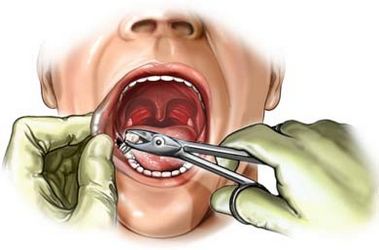Removal of a tooth
Description tooth extraction
The procedure involves removing the tooth from the buccal cavity.

Reasons for tooth extraction
While dental techniques can save many teeth, sometimes they must be removed. Causes for tooth extraction are:
- The tooth is too badly damaged or impossible to restore using root canal cleaning;
- Infection dental nerve;
- The negative impact on the normal growth of Teeth;
- Some of gum disease;
- Bone, the gum or tissue can not keep the tooth.
Possible complications of tooth extraction
Complications are rare, but no procedure does not guarantee the absence of risk. If you plan to tooth extraction, you need to know about possible complications, which may include:
- Bleeding;
- Infection;
- Nerve Damage.
Factors, that may increase the risk of complications include:
- Smoking;
- Poor diet;
- Poor overall health;
- The use of some drugs. Tell your dentist about medicines, that you take.
How is tooth extraction?
Preparation for the procedure
Dentist, likely to hold the next:
- Careful examination of the teeth;
- X-rays of teeth – test, which uses X-rays to take pictures of structures inside the body, especially bones.
Anesthesia
They can be used the following types of anesthesia:
- Local anesthesia – anaesthetises area procedures. It is given as an injection;
- General anesthesia – blocks pain and the patient support in a sleep state during operation. Administered intravenously in the arm or hand.
Procedure tooth extraction
If the tooth is badly damaged (is a right), doctors removed part of the gum tissue, to get to the remains of the tooth. Using tongs, Dentist captures the tooth and gently shakes him to the side. This will weaken the teeth and a torn ligament, which hold the tooth. The tooth will be removed, in the place of extraction of a blood clot is formed. To stop bleeding dentist can fit into the hole with a cotton swab. In some cases, the doctor will put a few stitches, to sew the edge of the gums.
Immediately after tooth
Cotton swab should for some time remain in place. This will reduce bleeding and form a blood clot in the tooth alveoli (tooth hole, a recess in the jaw, which is the root of the tooth). If bleeding continues, We need to change the tampon every 20-30 minutes. If all goes well, leave the tampon in place for 3-4 hours.
How long will the removal of a tooth?
The procedure takes about 20 minutes, but can take longer, if held firmly seated tooth removal.
Removal of a tooth – Will it hurt?
You will feel pain in the jaw. Your dentist can give you pain medicine.
Care after tooth extraction
After returning home, follow these steps:, to ensure the normal recovery:
- To reduce swelling, apply ice to the area for a tooth extraction 10 minutes at a time;
- Do not remove a blood clot, which is formed in a wound. Do not spit or rinse your mouth for the first 24 hours after tooth;
- Do not smoke;
- Keep, to food particles clogged tooth alveolus;
- Do not use drinking straws for the first 24 hours after tooth;
- Start by rinsing your mouth 24 hour after treatment. Use of the solution 0,5 teaspoon salt, diluted in a glass of warm water;
- Eat a soft or liquid diet for the first 24 hours;
- Avoid activity during the first 24 hours. During subsequent 1-2 days need to limit strenuous activity;
- Use a toothbrush and floss for dental care. This will help prevent infection at the site of tooth extraction;
- Be sure to follow your doctor's instructions.
First 24 hours may be some swelling and bleeding. The initial healing period usually takes about 1-2 weeks. New bone and gum tissue will close alveolus.
The absence of a tooth can lead to displacement of the teeth, malocclusion or zatrudnenyyu zhevanyya. Your dentist may try to set in place the tooth implant, dental bridge or denture.
Contact your dentist after tooth extraction
Returning home, it is recommended to consult a doctor, if there was any of the following symptoms of:
- Signs of infection, including fever and chills;
- Redness, edema, severe pain or discharge from the dental alveoli;
- Excessive bleeding, which lasted more than four hours after the operation;
- Pain, which does not pass after taking pain medication appointed;
- Cough, breathlessness, chest pain, or severe nausea or vomiting;
- Other painful symptoms.
